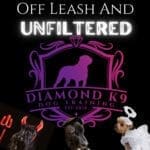Build a Healthy Relationship with Your Puppy

/
RSS Feed
In this episode of Off Leash and Unfiltered, Kati Peppe—owner of Diamond K9 Dog Training in Biddeford, Maine—cuts through puppy-raising anxiety. She explains why early management (gates, crates, leashes), clear marker training, and timely, fair corrections create a confident puppy and a calm household—without “ruining the bond.” You’ll learn what to prioritize in the first weeks, when to say “no,” and how to turn the walk into your best relationship-builder.
Episode Highlights
- Don’t overthink it: Associations are changeable; mistakes aren’t permanent.
- First-days plan: Prioritize management—crate, leash, gates—over constant redirection with food.
- Marker training: Charge a clicker or “yes,” then teach one behavior at a time (sit, place).
- Avoid unhealthy attachment: No shadowing, no bed-sleeping yet; teach being alone is safe.
- Affection with intent: “What you pet is what you get”—don’t reward pushy or fearful states.
- Introduce “no” + consequence: Selectively address biting/jumping; use an effective, fair punisher (e.g., towel bonk) so the lesson sticks.
- Prong-collar timeline: Around 12–16 weeks, start leash communication; build a loose, follower-style walk.
- Long line & engagement: Build recall on a long line; use click-&-feed turns/stops to grow attention.
- Multi-pet intros: Slow, structured, and advocated; neutral exposure first, greetings later.
- Older-dog variant: Same pillars, faster pace—set boundaries immediately to reset habits.
Minute-by-Minute Breakdown
- 01:55 – Why this topic: Kati’s puppy + a puppy in board & train; bonding worries addressed.
- 02:58 – Board & train concerns: will it hurt attachment? What matters long-term.
- 04:03 – Redirection vs. real conversations: why “just give a toy” isn’t enough.
- 05:01 – Relax: associations can be rebuilt; trauma fears are overblown.
- 05:44 – First few days = management: crates, leashes, gates; prevent rehearsals.
- 07:44 – Handling mouthing: leash pressure or small pops; don’t stuff treats for biting.
- 08:27 – Start structure now: crate comfort, no shadowing, no bed; prevent accidents/chewing.
- 09:41 – Markers 101: charge a clicker/“yes,” then food follows the marker—precision matters.
- 11:04 – Teach sit and place; record upcoming demo plans.
- 11:44 – Use food to build new skills; keep sessions focused.
- 12:32 – One behavior per mini-session; avoid conflating cues by alternating too soon.
- 13:18 – Petting pitfalls: constant touching and co-sleeping can seed dependency.
- 14:17 – You don’t fully “know” the puppy yet; genetics bloom later.
- 15:23 – Why endless affection can create a soft “pez-dispenser” handler image.
- 16:22 – “Nervous dominant” tendencies and how affection timing can inflate issues.
- 17:18 – Pattern better behavior: pause affection until the pup settles.
- 19:00 – Management + guidance beats indulging pushy demands.
- 19:59 – “What you pet is what you get”: even eye contact/talk can reinforce the wrong thing.
- 21:03 – Don’t soothe fear; intervene neutrally so uncertainty doesn’t get rehearsed.
- 21:45 – Start teaching now—don’t wait for adulthood to set boundaries.
- 22:44 – Introduce “no” and a proper punisher; pick your early battles.
- 25:05 – Relationship standard: you have expectations and you enforce them.
- 25:54 – First conversation: no teeth on people; timing depends on puppy & intensity.
- 26:37 – Towel bonk explained: effective, humane, and how firmness varies by dog.
- 28:03 – Don’t desensitize tools with weak follow-through.
- 28:54 – Next target: jumping—mark “no,” follow with a consequence.
- 29:45 – 12–16 weeks: intro prong collar; bust myths; why it’s safer and clearer.
- 30:40 – Skip heeling for tiny pups; use a long line and build recall first.
- 31:38 – Long-line recall reps; confidence through success.
- 32:28 – Why prong’s even pressure aids leash communication (not pokey/sharp).
- 33:27 – Walking = leadership: loose leash, follow the human, no constant sniffing/marking.
- 34:28 – Leash engagement drill: click-&-feed on turns/stops; tiny pops if pup blows past you.
- 36:01 – Short, loose leash rules; keep position without nagging.
- 36:46 – Finishing the puppy-phase relationship before adolescence hits.
- 37:45 – 3–5 months: prong + structured walk = big milestone.
- 38:37 – 5–7 months: new genetics “show up”; expect novelty and hold standards.
- 39:21 – Multi-animal homes: neutral exposure first; advocate during intros.
- 40:12 – Adult-dog variant: move faster; boundaries day one.
- 41:14 – Fix barking/jumping/kennel chaos now—don’t let momentum snowball.
- 43:57 – Be different from past homes: clear rules + consistent follow-through.
- 45:43 – Board & train notes: dogs are resilient; short puppy programs preserve bonding time.